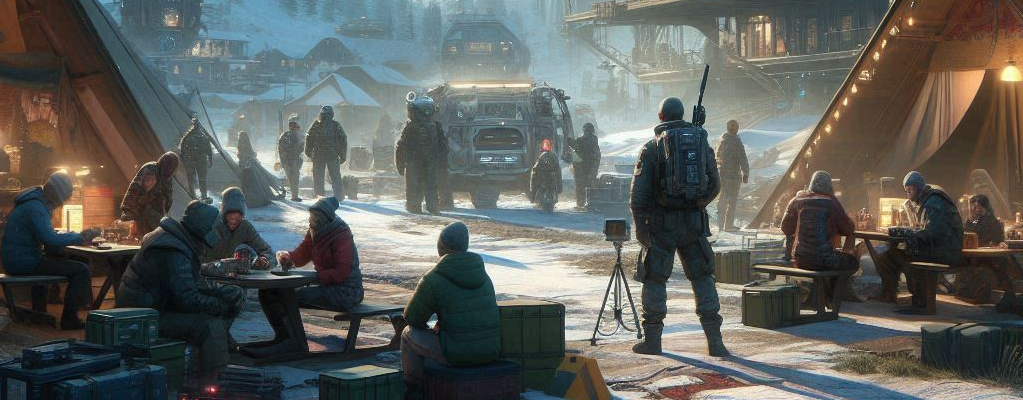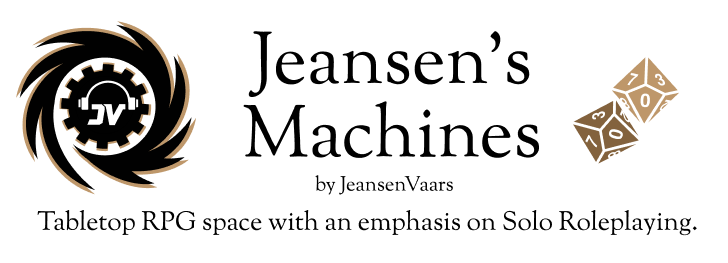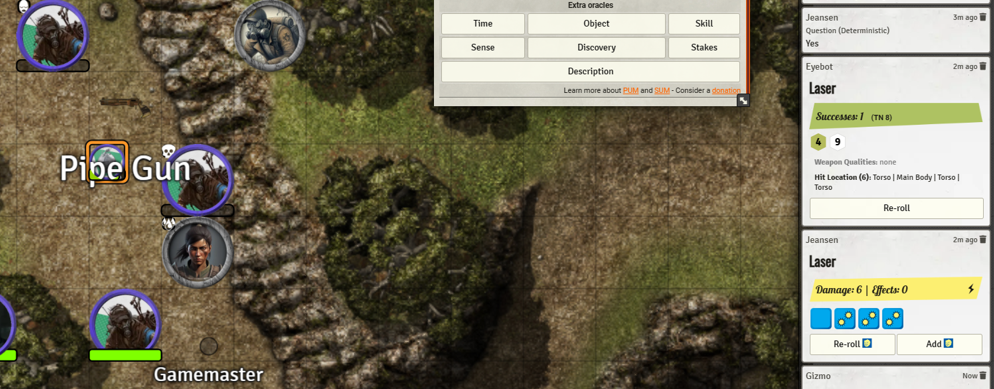JV’s Scene Designer

You’ve got an ongoing RPG story, an idea of where things are and what the characters are doing. But you need to zoom in, what can exactly happen next? How can we proceed and move towards the story? What is the next trouble or challenge the characters are going to face?
Update! Check out my new version of the Scene Designer JV’s Scene Designer 2.0
Table of Contents
- 1. Scene type
- 2. Scene challenge
- 3. Scene Factor
- When to use
- Usage advice
- Usage example
- 123. Simplified Version
- Conclusions
I designed this after thinking, and thinking, of a way to define the way a game can unfold. This can be used either for solo, GM-less or any kind of game really. What I like about it, is that it reminds us that we are playing an RPG, and that the characters need to take action in order to move things forward. The question is, how? Three steps with d10 dice!
- Scene type
- Scene challenge
- Scene factor
1. Scene type
| d10 | Scene Type |
|---|---|
| 1 | Plot Complication or Twist |
| 2 | Character against Plot |
| 3 | Circumstance against Plot |
| 4 | Circumstance favoring Plot |
| 5 | Character favoring a Plot |
| 6 | World Building |
| 7-10 | Plot Significant Progress |
If you have played Word Mill Games’ Mythic GM Emulator, you must be familiar with the “Focus” table. That is, how is the scene participating in the game? What role does it play? Here, you can either use your favorite focus table, or use this one as inspiration.
Progress is important, in my opinion, to keep us engaged. Scene type proposal favors making progress within a plot, and for things to happen related to the main story hooks. Roll randomly if you have more than one.
Following Mythic design, you can interpret or even replace these as a focus table. For example, you can use theme based focus tables or include important type of events that have their own personality.
For Plot Complication or Twist, you can check out this article: Twists and Complications
World building can represent filler time, it is there to remind us that sometimes not everything needs to be on fire all times. A drink in a tavern, setting camp, or turning on the radio for music, are all colorful but important in a game, that let you expand what you know about the world.
SKIP the Scene Type check if you know what’s your next scene about. I rather prioritize your cool ideas over a souless random table 🙂
2. Scene challenge
| d10 | Scene Challenge |
|---|---|
| 1 | Roll two of these! |
| 2 | Knowledge Test |
| 3 | Endurance test |
| 4 | Athletic test |
| 5 | Craft test |
| 6 | Intelligence test |
| 7 | Perception test |
| 8 | Social test |
| 9 | Specialist test |
| 10 | Combat! |
Usually we want our characters to take action, and to keep it relevant to the system or mechanics we are using. My advice here is that you build a table with the list of skills or mechanics that your system is using, and randomly rolling dice for it. Since this scene designer is d10 based, you can use either the following or build your own with your system’s skills.
These are subject to interpretation, although I may need to clarify that specialist tests represents any specialization requirements based on the setting. For example, hacking, magic or medicine. It represents crafty skills that only certainly trained characters can take over.
These challenges can also come in a pair. Re-roll as necessary, but never end up with more than two challenge tests. Remember, these do not mean these are the only tests on your scene, just one feature of it.
3. Scene Factor
| d10 | Scene Factor |
|---|---|
| 1-4 | Regular challenge |
| 5-6 | Difficult challenge |
| 7-8 | Requires help |
| 9-10 | Long or staged |
Each challenge has a factor. This will represent the specific feature of the challenge. Along the Scene challenge, roll a factor.
If you get multiple challenges on a scene, I advise having them all share the same factor. The teamwork tasks highlight the fact that a single character cannot do this on her own.
Long task, or staged tasks, represent particularly long solutions. Such as a Dramatic Task in Savage Worlds or a Challenge in FATE Core. Consider what can happen during that time, or what risk can there be if characters take way too long.
When to use
My recommendation: on demand.
This scene designer can very well inspire you to come up with what can happen next in your game, during the scene preparation stage. You may also have a clear idea about what will the characters do next, where they will go, or what they want, but don’t know exactly how they will get it, given they will have to work hard for it.
This system is not meant to represent the core of the scene, or to replace the most reasonable next scene you have in mind. If your next scene is for sure a combat scene, then don’t use the scene designer, or if you use it, think of it as a twist or detail in the scene. For example, during a diplomatic mission, you may get an “Athletics Test”, well… that could mean the employee serving the food dropped his tray accidentally, and your character was there to roll a test to see if he can save the meal (if he wants to). Thus, not only adding color to the scene, but also a sense of world building and why not a twist!
A different usage for the Scene Designer is actually a side-quest or a small mission. Your characters need information, and in exchange, somebody asks them a favor, what could it be? Well, you can use the scene designer to help yourself. Perhaps even that favor they ask you to, takes you also towards your own mission!
Usage advice
The Scene Desginer‘s challenge does not necessarily need to be the most important test of your scene. Its main purpose is for inspiration. If your characters were already supposed to be jumping from a cliff with parachutes, then don’t let the Scene Designer change it, and you may even skip the scene type check. It can however add a twist to the scene. If you are, however, clueless about the next scene, then let the Scene Designer’s challenge indeed be the core of your scene!
Remember not to hide plot progress behind tests. Fail forward. The story should keep going even when characters fail a perception test. What may change is only how clear, how fast or how well curated are the clues they find. But never should a perception roll block the story and waste all the effort the characters are investing in!.
The Scene Designer will help you keep a good balance of skill usage across your game, reminding you that not everything is combat, traps or stealth. By getting certain skill set combinations, you will figure out ways of using it and adapting them to your story! Play around placing your actual system’s mechanics in the challenge table, so you get less frequently used skills, too!.
Last, but not least, remember to use it with oracles, random events or random tables. However though, better rely on your own ideas, context and motivations more than having a battery of information. In some situations, you will be overloaded with inspirational content and will end up working hard tying up things together, rather than moving forward your game.
Usage example
Your characters are looking for a specific Spaceship in a galaxy, and their current lead is to onboard a neutral orbital station to ask the leader of a mercenary company that is currently located in there. Your characters dock, and come through migrations. “What will make the onboarding scene interesting?”
- 8: Plot significant progress
- 6: Intelligence test
- 1: Regular challenge
After thinking for a moment, you come up with having in the scene, one member of the mercenary company you are looking for is actually there (Plot progress), an intelligence test (What is his role there? logic, culture, technology, or any relating clue), and a regular challenge (nothing particularly difficult). As you can see, this helped to set up a scene towards the story with little effort.
Next, your characters figure that this mercenary member is reachable, so they approach him, knowing his role in the orbital station, and ask him where they can find his leader. The mercenary leads them to a certain location in the orbital station… “but what can happen next?”
- 6: Plot unrelated event
- 1: Roll twice: 3 – Endurance Test. 4 – Athletics Test
- 7: Requires teamwork
You think for a moment, perhaps ask a few oracle questions or investigate, and you end up in a scene where your characters travel through a sector where a pipe explodes! (Plot unrelated). A gas is released, and doors get closed for an emergency, and not only characters might have to resist a poisonous gas or hold their breath (endurance test), but also need to figure out a way to jump and climb alloy containers (athletics test) to find an exit room! One of them might have to break open a door, while others figure out the gas releasing mechanism, or help some civilians!
123. Simplified Version
If rolling on multiple tables is too much for you, then maybe this simplified version helps. However, you will lose some traction from the Scene Type table.
| 1 | Regular Endurance Test |
| 2 | Regular Athletic Test |
| 3 | Regular Specialist Test |
| 4 | Regular Social Test |
| 5 | Regular Perception Test |
| 6 | Regular Intelligence Test |
| 7 | Regular Craft Test |
| 8 | Hard Endurance Test |
| 9 | Hard Athletic Test |
| 10 | Hard Specialist Test |
| 11 | Hard Craft Test |
| 12 | Teamwork Athletic + Craft |
| 13 | Teamwork Endurance + Craft |
| 14 | Teamwork Specialist + Craft |
| 15 | Teamwork Social + Intelligence |
| 16 | Teamwork Perception + Specialist |
| 17 | Long or Staged Athletics + Craft |
| 18 | Long or Staged Specialist + Intelligence |
| 19 | World Building |
| 20 | Combat! |
Conclusions
Hope you have liked this scene designer system. I will be for sure play testing it, as I have been needing it lately. I have to admit, the idea was inspired from Tricube Tales Solo Rules, where a scene test included what kind of challenge the PCs would go through in such a scene. Likewise, I have expanded this rule while adding the focus point of view towards the main plots.
Feedback? Thoughts? Ideas? all welcome!. JV
Updated: 26.05.2022






